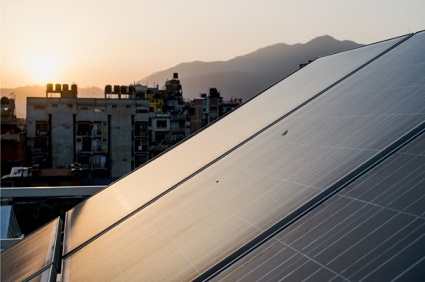On Earth Day 2018, eleven participants traveled to Nepal with GRID Alternatives to install a 1.2 kW off-grid solar system in Chitwan National Park. Here, Marissa Leshnov, GRID Bay Area’s SolarCorps Workforce and Volunteer Fellows, recounts some of the moments that shaped her experience in Nepal’s sub-tropical plains.
--
Nepal is a land of extremes locked between the two most populous countries in the world, with thousand-year-old temples and ever-rising mountaintops within its borders. Within this unique cultural and geographic landscape, however, Nepal’s people are by far its most interesting asset. For ten days, I traveled in Nepal with GRID Alternatives to install solar on an off-grid observation tower in Chitwan National Park. Although it’s typically the quantifiable impacts of installing solar that resonate with me long after the switch is flipped, the people I met in Nepal shaped my experience in a way that numbers cannot communicate.
Chitwan is Nepal’s first National Park– inspired by Yellowstone in the U.S. – and a World Heritage Site, providing shelter to rare Bengal tigers and single-horned Asiatic rhinoceroses. Outside of this stretching wilderness lies a mile-wide stretch of land known as the buffer zone, which is made up of pristine wilderness and human settlements in equal parts.
Life in the buffer zone is rather extraordinary, in that the people there must balance their everyday human needs for shelter, employment, and food, alongside their duties to protect the wildlife and wilderness that borders and even permeates their settlements. Leading this effort are several buffer zone committees. Visitors to Chitwan can support the committees financially by staying in one of the eleven observation towers in the buffer zone. The user committees then direct the income generated by travelers towards local conservation, workforce development, and women’s empowerment programs.
One of my favorite moments in Nepal was visiting the Mrigakunja Bufferzone Committee’s office in Sauraha. I believe everyone could learn from the committee’s example in prioritizing gender equality in their organizational structure. For instance, their constitution requires that there must be one female subcommittee group for every male one. Furthermore, if the committee’s president is male, then only female candidates can be elected to the vice president role. This ensures that no decisions are made without representation for roughly half of the buffer zone’s residents.
Later that day, we visited a shop in which one of the committee’s job trainees sold his crafts. I bought two beautiful, handmade bracelets from him. As a SolarCorps Fellow supporting GRID’s workforce development programs in the Bay Area, it was a full-circle moment for me to support the hard work of one of the user committee’s job trainees.
I am also grateful for having had the opportunity to meet Sita Adhikari, one of the most inspiring women I now know.  Sita co-founded Empower Generation, a social enterprise that provides income-generating opportunities to women entrepreneurs by distributing solar lamps, improved cookstoves, and other critical household products. Through this model, rural women can gain the experience and confidence to become business owners, and remote communities can access clean energy technology that is culturally appropriate. To see this in action, we met with one of Sita’s mentees, who arrived in style on a new motorbike. She told us she was able to afford private transportation through her small business, and it was palpable how much she inspired the children in her community.
Sita co-founded Empower Generation, a social enterprise that provides income-generating opportunities to women entrepreneurs by distributing solar lamps, improved cookstoves, and other critical household products. Through this model, rural women can gain the experience and confidence to become business owners, and remote communities can access clean energy technology that is culturally appropriate. To see this in action, we met with one of Sita’s mentees, who arrived in style on a new motorbike. She told us she was able to afford private transportation through her small business, and it was palpable how much she inspired the children in her community.
There is something both inspiring and validating about meeting like-minded folks who are doing good work for the planet and its people on the other side of the world. You feel as though you’re connected to something bigger than yourself or your community.
Shortly before my flight home, I made a detour with a few other travelers to Boudhanath, the largest monument of its kind in Asia and a pilgrimage site for Buddhists around the world. While there, a loud and joyful group of young monks began to parade around the stupa, beating drums and waving colorful Buddhist flags with triumph. We hadn’t known that our last day in Nepal coincided with Buddha Jayanti, the day that many Nepalis celebrate the founding Buddha’s birthday. I took comfort in the symbolism of the moment, knowing that that was Nepal’s way of inviting me back someday.

